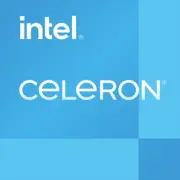Intel Celeron J3455E

Intel Celeron J3455E: An Affordable Processor for Compact Systems
April 2025
1. Key Features: Modest, Yet Functional
The Intel Celeron J3455E processor, released in 2016, remains a popular choice for budget and energy-efficient systems. Despite its age, its Apollo Lake (14 nm) architecture and specifications are suitable for low-demand tasks.
Technical Details:
- Cores and Threads: 4 cores, 4 threads (no Hyper-Threading).
- Frequencies: Base — 1.5 GHz, Turbo mode — up to 2.3 GHz.
- TDP: 10W — perfect for passive cooling.
- Graphics: Intel HD Graphics 500 (base frequency 250 MHz, turbo — 750 MHz).
- Performance: Geekbench 6 — 296 (single-core), 848 (multi-core).
Key Features:
- Support for 4K via HDMI 1.4 and DisplayPort.
- Integration with VP9 and HEVC hardware decoding for streaming video.
- Compatibility with Windows 11 (requires workarounds due to lack of TPM 2.0 in the chip).
2. Compatible Motherboards: Limited Choices
The Celeron J3455E uses a BGA socket, meaning the processor is soldered onto the board and cannot be replaced. This limits the choice of ready-made solutions.
Examples of Boards (2025):
- ASRock J3455-ITX (Mini-ITX, 2x SATA, HDMI, 1x LAN) — $90–$110.
- Fujitsu D3644-B (Micro-ATX, 4x USB 3.0, COM port) — $120–$140.
Recommendations:
- Look for boards with M.2 for Wi-Fi (e.g., ASRock J3455B-ITX).
- For media centers, HDMI 2.0 or DisplayPort are important.
- Check for support for SATA 3.0 and USB 3.1 — this will accelerate SSD performance.
3. Memory: DDR3L and Limitations
The processor supports DDR3L-1866 and LPDDR3-1866, but does not work with DDR4 or DDR5.
Selection Tips:
- Maximum capacity — 8 GB (2x4 GB).
- Use dual-channel mode to improve graphics performance.
- Example: Patriot Signature Line DDR3L-1866 4 GB — $15 per module.
Limitations:
- Low memory bandwidth — a bottleneck for multitasking.
4. Power Supplies: Low-Power and Quiet
With a TDP of 10W, a system based on the J3455E consumes no more than 25–30W under load (with SSD and peripherals).
Recommendations:
- Power supplies rated 150–200W (e.g., FSP Flex-ATX 200W — $40).
- For completely passive builds, PicoPSU rated at 80–120W ($50–$70) is suitable.
- Avoid cheap noname units — even low-power systems require stable voltage.
5. Pros and Cons: A Balance for Niche Tasks
Pros:
- Energy Efficiency: Operates with Power Delivery via USB-C (e.g., in Asus PN40 mini PC).
- Price: Ready-made systems based on J3455E start at $150 (new).
- Silence: Passive cooling with no fans.
Cons:
- Weak Performance: Struggles with Photoshop, 3D rendering, or modern games.
- Outdated Memory: DDR3L limits upgrade options.
- No Processor Replacement: BGA socket makes upgrades impossible.
6. Use Cases: Where J3455E is Relevant in 2025
Office and Web:
- Working with documents, browsers (up to 10 tabs), Zoom. Example: Office PC based on Minisforum M1 (price — $170).
Media Center:
- 4K playback via Kodi or Plex (with hardware decoding).
Smart Home and IoT:
- Home Assistant server or sensor node.
Gaming:
- Only old titles like Half-Life 2, Minecraft (at low settings, 720p).
7. Competitors: What to Choose Instead of J3455E
AMD A6-9500E (2017):
- Pros: DDR4 support, better Radeon R5 graphics.
- Cons: Higher TDP (35W), more expensive (systems from $200).
Qualcomm Snapdragon 7c (2023):
- Pros: ARM architecture, battery life, Wi-Fi 6 support.
- Cons: Limited compatibility with x86 software.
Intel N100 (2023):
- Pros: Xe graphics, DDR5, TDP 6W.
- Cons: Price (systems from $250).
8. Assembly Tips: How to Not Go Wrong
For Media Centers:
- Case: Akasa Turing (passive cooling, $60).
- Storage: Kingston A400 240 GB ($25).
- OS: LibreELEC for minimal loads.
For Office:
- Monitor: Dell P2422H (24″, HDMI, $160).
- Peripherals: Logitech MK270 (keyboard + mouse, $25).
What to Avoid:
- HDD instead of SSD — this is a speed killer.
- Attempting to run Windows 11 without modifications.
9. Conclusion: Who is the Celeron J3455E Suitable For
This processor is suitable for those who need:
- A budget PC for basic tasks.
- An energy-efficient media center or server.
- A compact system without fans.
Target Audience:
- Students, office workers, smart home enthusiasts.
Alternatives in 2025:
If the budget allows, it’s better to opt for the Intel N100 or AMD Ryzen 3 7320U — they offer modern technology and future-proofing.
Summary: The Intel Celeron J3455E is not a king of performance but a reliable workhorse for specific tasks. Its strengths are price and minimalism, not power.
Basic
CPU Specifications
Memory Specifications
GPU Specifications
Miscellaneous
Benchmarks
Compared to Other CPU
Share in social media
Or Link To Us
<a href="https://cputronic.com/index.php/cpu/intel-celeron-j3455e" target="_blank">Intel Celeron J3455E</a>